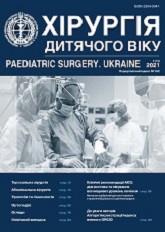Cystoscopic features of the ureteral orifices in children with vesicoureteral reflux
DOI:
https://doi.org/10.15574/PS.2021.72.36Keywords:
vesicoureteral reflux, ureteral orifice, cystoscopy, childrenAbstract
Purpose – to establish cystoscopic prognostic criteria for vesicoureteral reflux (VUR) in children.
Materials and methods. Clinical material covers 270 patients with VUR II–IV grades aged 9 months to 14 years and 22 healthy children. The study included patients with VUR in the period of clinical and laboratory remission without symptoms of neurogenic bladder. During cystoscopy, the condition of the bladder mucosa was assessed; location, shape, hydrodistention degree, and ureteral orifices contractility.
Results. Patients with VUR were diagnosed ureteral orifices in the form of: horseshoes – 127 (47.04%) patients, stadium – 106 (39.26%) and golf holes – 37 (13.7%). They were in the zones: A – 13 (4.81%) children, B – 154 (57.04%), C – 67 (24.81%), D – 36 (13.33%), and were characterized by the hydrodistention degree: H0 – 7 (2.59%) patients, H1 – 173 (64.07%), H2 – 60 (22.22%) and H3 – 30 (11.11%). In children with VUR, sluggish peristalsis of the ureter orifices clearly prevailed – 252 (93.33%) cases, relative to active peristalsis in only 18 (6.67%) patients.
Conclusions. For ureteral orifices in the form of a stadium and with more pronounced signs of deepening, which are shifted to zone B and laterally to the sidewall of the bladder, with a hydrodistention degree above H1 has a positive association with VUR at the highest specificity of tests.
Unfavorable prognostic diagnostic markers for effective minimally invasive interventions in patients with VUR should be considered ureteral orifices, which combine such morpho-topographic characteristics as pronounced signs of deepening to the shape of a golf hole, lateralization to the sidewall of the bladder in zone D, and hydrodistention H3 degree.
The research was carried out in accordance with the principles of the Helsinki declaration. The study protocol was approved by the Local ethics committee of all participating institution. The informed consent of the patient was obtained for conducting the studies.
No conflict of interest was declared by the authors.
References
Aksenova ME, Turpitko OY, Gusarova TN, Nazarova NF, Ignatova MS. (2001). The role of urinary tract infection in the formation of reflux nephropathy in children. Nephrology and dialysis. 2: 296-297.
Basic J, Golubovic E, Miljkovic P et al. (2008). Microalbuminuria in children with vesicoureteral reflux. Renal failure. 30 (6): 639-643. https://doi.org/10.1080/08860220802134805; PMid:18661415
Glassberg KI, Hackett RE, Waterhouse K. (1981). Congenital anomalies of the kidney, ureter, and bladder. Urology. By Harry S. Goldsmith, Lester Karafin, and A. Richard Kendall. Vol. 1. Philadelphia: Harper & Row.
Jacyk SP, Burkin AG, Sharkov SM et al. (2014). Comparative evaluation of methods of surgical correction of vesicoureteral reflux in children. Questions of modern pediatrics. 13 (2): 129-131. https://doi.org/10.15690/vsp.v13i2.984
Khoury AE, Bagli DJ. (2016). Vesicoureteral Reflux. Campbell-Walsh urology eleventh edition review. By MacDougal, William Scott, and Meredith F. Campbell. Philadelphia: Elsevier.
Kirsch AJ, Kaye JD, Cerwinka WH et al. (2009). Dynamic hydrodistention of the ureteral orifice: a novel grading system with high interobserver concordance and correlation with vesicoureteral reflux grade. The Journal of urology. 182 (4S): 1688-1693. https://doi.org/10.1016/j.juro.2009.02.061; PMid:19692002
Lackgren G, Kirsch AJ. (2010). Endoscopic treatment of vesicoureteral reflux. BJU international. 105 (9): 1332-1347. https://doi.org/10.1111/j.1464-410X.2010.09325.x; PMid:20500570
Lyon RP, Marshall S, Tanagho EA. (1969). The ureteral orifice: its configuration and competency. The Journal of urology. 102 (4): 504-509. https://doi.org/10.1016/S0022-5347(17)62184-0
Nakonechnyy RA, Nakonechnyi AY. (2013). Vesicoureteral reflux in children: endovesical correction methods. Pediatric Surgery. 2: 19-24.
Nakonechnyy RA. (2015). The efficiency of mini-invasive treatment of vesicoureteral reflux in children. Urology. 2: 74-78.
Park John M. (2006). Vesicoureteral Reflux: anatomic and functional basis of etiology. The Kelalis-King-Belman Textbook of Clinical Pediatric Urology. Ed. Steven G Docimo, Douglas A Canning, Antoine E Khoury. Fifth ed. CRC Press. https://doi.org/10.1201/b13795-47
Romanenko GO, Kundin VYU. (2010). Renoscintigraphy investigation of cystoureteral reflux in children with various kidney and urinary tract pathologies. Ukrainian Radiological Journal. 13 (3): 320-323.
Ryabtseva AV, Jacyk JV, Fomin DK. (2010). New approaches to the diagnosis of vesicoureteral reflux in children. Pediatric Pharmacology. 7 (3): 95-97.
Sargent MA. (2000). Opinion: what is the normal prevalence of vesicoureteral reflux? Pediatric radiology. 30: 9. https://doi.org/10.1007/s002470000263; PMid:11009294
Tanagho EA, Nguyen HT. (2013). Vesicoureteral Reflux. Smith & Tanagho's General Urology. By Smith Donald Ridgeway, Tom F Lue, Jack W McAninch. Eighteenth ed. McGraw Hill Medical.
Zorkin SN, Gusarova TN, Borisova SA, Barsegyan ER. (2011). Endoscopic correction of vesicoureteral reflux in children. Pediatric Surgery. 2: 23-27.
Downloads
Published
Issue
Section
License
The policy of the Journal “PAEDIATRIC SURGERY. UKRAINE” is compatible with the vast majority of funders' of open access and self-archiving policies. The journal provides immediate open access route being convinced that everyone – not only scientists - can benefit from research results, and publishes articles exclusively under open access distribution, with a Creative Commons Attribution-Noncommercial 4.0 international license(СС BY-NC).
Authors transfer the copyright to the Journal “PAEDIATRIC SURGERY.UKRAINE” when the manuscript is accepted for publication. Authors declare that this manuscript has not been published nor is under simultaneous consideration for publication elsewhere. After publication, the articles become freely available on-line to the public.
Readers have the right to use, distribute, and reproduce articles in any medium, provided the articles and the journal are properly cited.
The use of published materials for commercial purposes is strongly prohibited.

